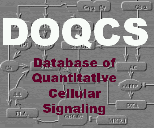| |
Name | Pathway Name /
Pathway No. | Accession
Type | Initial
Conc.
(uM) | Volume
(fL) | Buffered | Sum Total Of |
| 1 | activeIP3R | Othmer-Tang-mode
l
Pathway No. 171Network | 0 | 1000 | No | - | |
| | This represents the active IP3 Receptor channel that conducts Ca across the ER membrane in the Othmer-Tang model. Its 0 uM initial concentration represents no active channels present under basal conditions. Its levels build up upon stimulation. |
| 2 | ER_leak | Othmer-Tang-mode
l
Pathway No. 171Network | 2 | 1000 | No | - | |
| | The channel that leaks Ca from the stores to the cytoplasm This channel is not sensitive to any potential differences. Channel permeability is 0.1, as used in the O-T model (Tang et al, Biophys J 70, 1996) |
| 3 | IP3R | Othmer-Tang-mode
l
Pathway No. 171Network | 0.1 | 1000 | No | - | |
| | IP3 Receptor with no ligand bound |
| 4 | Ca.IP3.IP3R | Othmer-Tang-mode
l
Pathway No. 171Network | 0 | 1000 | No | - | |
| | IP3-IP3Receptor complex with Ca bound at the activating site. |
| 5 | IP3.IP3R | Othmer-Tang-mode
l
Pathway No. 171Network | 0 | 1000 | No | - | |
| | IP3 Receptor with IP3 bound. This state does not conduct Ca as per Tang et al, Biophys J 70; 1996 |
| 6 | ER_pump | Othmer-Tang-mode
l
Pathway No. 171Network | 2 | 1000 | No | - | |
| | This pump represents the ATP-dependent pump that moves cytosolic Ca into the ER in the Othmer-Tang model. |
| 7 | Ca2.IP3.IP3R | Othmer-Tang-mode
l
Pathway No. 171Network | 0 | 1000 | No | - | |
| | THe Ca-IP3-IP3Receptor complex with additional Ca bound to the inhibitory sites. This is the inactive state of the channel. |
| 8 | IP3 | Othmer-Tang-mode
l
Pathway No. 171Network | 0.2 | 1000 | No | IP3(145)
| |
| | Inositol(145)trisphosphate in the cytoplasm. Levels are determined by the IP3-metabolism network |
| 9 | mirror_
Ca.IP3.IP3R | Othmer-Tang-mode
l
Pathway No. 171Network | 0 | 1000 | No | Ca.IP3.IP3R
| | 10 | CaEPump | CaRegulation
Pathway No. 170 | Network | 0.01 | 1000 | No | - | | | The calcium electrogenic pump: Mc Burney and Neering, TINS 10(4), 1987, 163-169. We treat the pump as a simple Michaelis-Menten enzyme. Levels are constrained tightly by the need to generate Ca oscillations within the Othmer-Tang model. | | 11 | Ca-leak-from-ext
racell | CaRegulation
Pathway No. 170 | Network | 0.0008 | 1000 | No | - | | | This represents the pool of Ca leak channels. The conc gradient is so large that this pool needs only small number of molecules. For an equilibrium at 0.1 uM we need flow of 36e3/sec. With a permeability of 0.01 and a conc gradient of 4mM->0.1 uM (4e4) we get flux = N * perm * g rad => N = 36e3 / (1e-2 * 4e3) = 900 if flux = 20e3, N =500, which is what we use. This works out to a concentration of 0.83 nM. | | 12 | capacitive_Ca_
entry* | CaRegulation
Pathway No. 170 | Network | 0.01 | 1000 | No | - | | | This mechanism has taken a while to be more tightly confirmed as probably being the TRP channel. The channel is implemented to match experimental observations about capacitative Ca entry. Levels are unchanged from the CaReg model used to generate non-oscillatory Ca response in the IP3 metabolism network. | | 13 | inact_cap_entry | CaRegulation
Pathway No. 170 | Network | 0 | 1000 | No | - | | | represents the portion of the capacitative-Ca entry channel which is blocked when there is lots of Ca sequestered in the stores | | 14 | Ca-sequester | CaRegulation
Pathway No. 170 | Network | 6.3328 | 160 | No | - | | | Sequestered Ca pool The vol is 0.16 * the vol of the cell as a whole. The Ca-sequester conc that we use is same as that used in our other models (see Bhalla and Iyengar, Science 283, 1999: 381-387 | | 15 | Ca30-Calseq | CaRegulation
Pathway No. 170 | Network | 0 | 160 | No | - | | | Calsequestrin with 30 Ca molecules bound | | 16 | Ca35-Calseq | CaRegulation
Pathway No. 170 | Network | 0 | 160 | No | - | | | Calsequestrin with 35 Ca molecules bound | | 17 | Ca20-Cal | CaRegulation
Pathway No. 170 | Network | 0 | 160 | No | - | | | Calsequestrin with 20 Ca molecules bound | | 18 | Ca15-Cal | CaRegulation
Pathway No. 170 | Network | 0 | 160 | No | - | | | Calsequestrin with 15 Ca molecules bound | | 19 | Ca25-Cal | CaRegulation
Pathway No. 170 | Network | 0 | 160 | No | - | | | Calsequestrin with 25 Ca molecules bound | | 20 | Ca40-Cal | CaRegulation
Pathway No. 170 | Network | 0 | 160 | No | - | | | Calsequestrin with 40 Ca molecules bound | |
